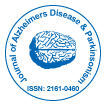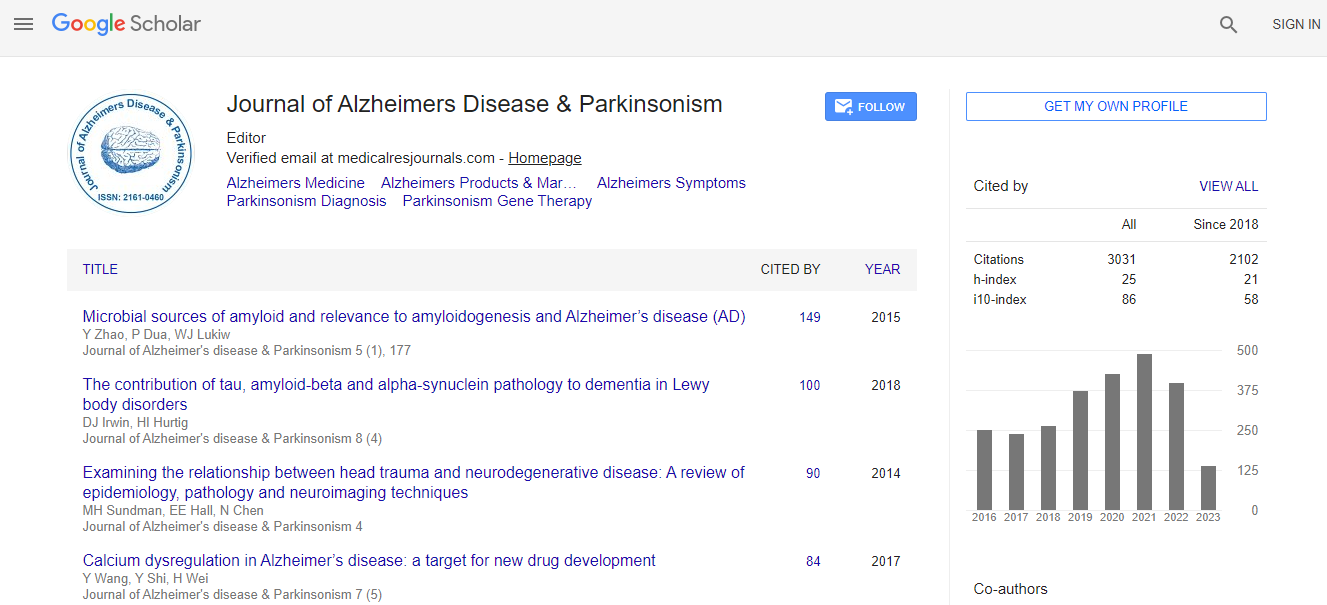Our Group organises 3000+ Global Conferenceseries Events every year across USA, Europe & Asia with support from 1000 more scientific Societies and Publishes 700+ Open Access Journals which contains over 50000 eminent personalities, reputed scientists as editorial board members.
Open Access Journals gaining more Readers and Citations
700 Journals and 15,000,000 Readers Each Journal is getting 25,000+ Readers
Google Scholar citation report
Citations : 4334
Journal of Alzheimers Disease & Parkinsonism received 4334 citations as per Google Scholar report
Journal of Alzheimers Disease & Parkinsonism peer review process verified at publons
Indexed In
- Index Copernicus
- Google Scholar
- Sherpa Romeo
- Open J Gate
- Genamics JournalSeek
- Academic Keys
- JournalTOCs
- China National Knowledge Infrastructure (CNKI)
- Electronic Journals Library
- RefSeek
- Hamdard University
- EBSCO A-Z
- OCLC- WorldCat
- SWB online catalog
- Virtual Library of Biology (vifabio)
- Publons
- Geneva Foundation for Medical Education and Research
- Euro Pub
- ICMJE
Useful Links
Recommended Journals
Related Subjects
Share This Page
Gait analysis under dual-task conditions: a biomarker for gait instability, falls, MCI and dementia
11th International Conference on Vascular Dementia
Bernard Auvinet
University of Rennes II, France
Posters & Accepted Abstracts: J Alzheimers Dis Parkinsonism
Abstract
Background: The dual-task test is unique as it reflects the motor cognitive interface, which is of great interest to detect deficits of motor-gait control and fall risk, but also may precede cognitive decline linked to MCI and dementia. Very few studies have focused on the relevance of gait analysis under dual-task conditions in elderly people on the basis of clinical approach.Methods: An observational study including 103 patients (mean age 76.3±7.2, women 56%) suffering from gait disorders, falls or memory impairment was conducted. Gait analysis under dual-task conditions was carried out for all patients. Three main Gait variables were measured: walking speed, stride frequency, and stride regularity. For each gait variable, the dual task cost was computed, and a quartile analysis was obtained. Nonparametric tests were used for all the comparisons (Wilcoxon, Kruskal-Wallis, Fisher or Chi² tests).
Results: Four clinical subgroups were identified: gait instability (45%), recurrent falls (29%), memory impairment (18%), and cautious gait (8%). The biomechanical severity of these subgroups was ordered according to walking speed and stride regularity under both conditions (single and dual-task conditions), from least to most serious as follows: memory impairment, gait instability, recurrent falls, cautious gait (p<0.01 for walking speed, p=0.05 for stride regularity). In a multivariate analysis of variance model for dual-task cost, there is a strong variable effect (p<0.01), but no clinical subgroup effect was noted. According to the established diagnoses of gait disorders, six main pathological subgroups were identified (musculoskeletal diseases (n=11), vestibular diseases (n=6), mild cognitive impairment (n=24), dementia (n=27), other central nervous system pathologies (n=24), and without diagnosis (n=8)). The subgroups mild cognitive impairment and dementia both showed a higher dual task cost for each variable compared to the osteoarthrosis and vestibular diseases combined (p=0.01), other CNS pathologies represent an intermediate subgroup with a potential cognitive impairment. According to the quartile analysis, we hypothesize that the fourth quartile value for each DTC may represent an interesting cut off value in clinical setting (DTC walking speed: 20%; DTC stride frequency: 15%; DTC stride regularity: 30%).
Conclusion: In clinical setting, gait analysis under dual-task conditions in elderly people suffering from gait disorders or memory impairment is of great value to assess the severity of gait disorders, to differentiate between peripheral pathologies and central nervous system pathologies (mainly MCI and dementia), to understand unexplained falls, to highlight the prediction of MCI syndrome, to inform about dementia progression. Change in gait performance while dual tasking may be used as a biomarker of pathologies with cognition disorders
Biography

 Spanish
Spanish  Chinese
Chinese  Russian
Russian  German
German  French
French  Japanese
Japanese  Portuguese
Portuguese  Hindi
Hindi 
